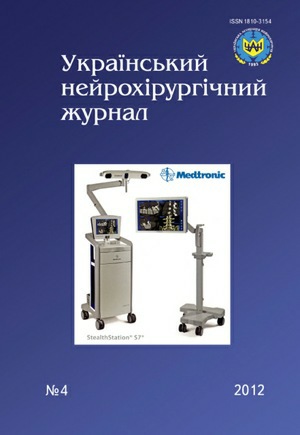Dynamics of neurophysiological parameters in patients with consequences of cervical spine injury under epidural electrostimulation
DOI:
https://doi.org/10.25305/unj.55641Keywords:
cervical spine trauma, epidural electrostimulation, diagnostics, evoked motor potentialsAbstract
Introduction. Method of epidural electrostimulation (EES) is considered to be one of the most promising areas of renewing surgery of the spinal cord.
Materials and methods. The results of treatment of 80 patients (90% — men, 10% — women) with consequences of cervical spine injury of different severity were analyzed. Clinical and neurological, neurophysiological (NPh) methods, including electroneuromyography (ENMG) and motor evoked potentials (MEP) registration were used.
Results. Using EES method in patients with spinal trauma consequences the improvement of cortical-spinal conductivity was achieved, in 76 (95%) — certain renewing of movement in a particular group of muscles. A direct correlation between results of motor recovery after EES according to clinical evaluation and MEP indices was found (r=0,6, P <0,01) in patients from different groups.
Conclusions. Clinical and NPh tests allow to estimate quantity of spinal cord conducting functions disorders before operation and provides objective criteria for evaluation of surgery effectiveness in patients with consequences of cervical spine injury.
References
1. Fehlings M, Perrin R. The role and timing of early decompression for cervical spinal cord injury: Update with a review of recent clinical evidence. Injury. 2005;36(2):S13-S26. [CrossRef] [PubMed]
2. Rabinowitz R, Eck J, Harper C et al. Urgent Surgical Decompression Compared to Methylprednisolone for the Treatment of Acute Spinal Cord Injury. Spine. 2008;33(21):2260-2268. [CrossRef] [PubMed]
3. Hamid S, Hayek R. Role of electrical stimulation for rehabilitation and regeneration after spinal cord injury: an overview. European Spine Journal. 2008;17(9):1256-1269. [CrossRef] [PubMed]
4. Lavrov I, Courtine G, Dy C et al. Facilitation of Stepping with Epidural Stimulation in Spinal Rats: Role of Sensory Input. Journal of Neuroscience. 2008;28(31):7774-7780. [CrossRef] [PubMed]
5. Oakley J, Prager J. Spinal Cord Stimulation. Spine. 2002;27(22):2574-2583. [CrossRef] [PubMed]
6. Gekht B, Kasatkina L, Samoylov M, Sanadze A. Elektromiografiya V Diagnostike Nervno-Myshechnykh Zabolevaniy [Electromyography In The Diagnosis Of Neuromuscular Diseases]. Taganrog: Izd-vo TRTU; 1997. Russian.
7. Zenkov L, Ronkin M. Funktsionalnaya Diagnostika Nervnykh Bolezney: Rukovodstvo Dlya Vrachey [Functional Diagnosis Of Nervous Diseases: Guidance For Doctors]. Moscow: MEDpress-inform; 2004. Russian.
8. Nikitin S, Kurenkov A. Metodicheskiye Osnovy Transkranialnoy Magnitnoy Stimulyatsii V Nevrologii I Psikhiatrii: Rukovodstvo Dlya Vrachey [Methodical Bases Of Transcranial Magnetic Stimulation In Neurology And Psychiatry: A Guide For Doctors]. Moscow: OOO «IPTS MASKA»; 2006. Russian.
9. Tsymbalyuk V, Yaminskyy Y. Rekonstruktyvno-Vidnovna Khirurhiya Spynnoho Mozku [Reconstructive Surgery Of The Spinal Cord]. Kiev: Avitsena; 2009. Ukrainian.
Downloads
Published
How to Cite
Issue
Section
License
Copyright (c) 2012 Lidiya Chebotariova, Albina Tretiakova, Iuriy Iaminskiy

This work is licensed under a Creative Commons Attribution 4.0 International License.
Ukrainian Neurosurgical Journal abides by the CREATIVE COMMONS copyright rights and permissions for open access journals.
Authors, who are published in this Journal, agree to the following conditions:
1. The authors reserve the right to authorship of the work and pass the first publication right of this work to the Journal under the terms of Creative Commons Attribution License, which allows others to freely distribute the published research with the obligatory reference to the authors of the original work and the first publication of the work in this Journal.
2. The authors have the right to conclude separate supplement agreements that relate to non-exclusive work distribution in the form of which it has been published by the Journal (for example, to upload the work to the online storage of the Journal or publish it as part of a monograph), provided that the reference to the first publication of the work in this Journal is included.









